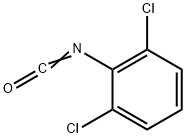
2,6-Dichlorophenyl isocyanate
- Product Name2,6-Dichlorophenyl isocyanate
- CAS39920-37-1
- CBNumberCB8758040
- MFC7H3Cl2NO
- MW188.01
- EINECS254-699-4
- MDL NumberMFCD00002003
- MOL File39920-37-1.mol
- MSDS FileSDS
Chemical Properties
| Melting point | 43-45°C |
| Boiling point | 101°C 5mm |
| Density | 1,015 g/cm3 |
| refractive index | 1.5500 (estimate) |
| Flash point | 76 °C |
| solubility | soluble in Toluene |
| form | powder to lump to clear liquid |
| color | White or Colorless to Almost white or Almost colorless |
| Water Solubility | decomposes |
| Sensitive | Moisture Sensitive |
| BRN | 608323 |
| CAS DataBase Reference | 39920-37-1(CAS DataBase Reference) |
| EPA Substance Registry System | Benzene, 1,3-dichloro-2-isocyanato- (39920-37-1) |
| UNSPSC Code | 12352100 |
| NACRES | NA.22 |
Safety
| Symbol(GHS) |
 
|
|||||||||
| Signal word | Danger | |||||||||
| Hazard statements | H300-H330-H334-H301+H311+H331-H315-H319-H335 | |||||||||
| Precautionary statements | P301+P310a-P304+P340-P320-P330-P405-P501a-P261-P280-P301+P310-P305+P351+P338-P311 | |||||||||
| Hazard Codes | T | |||||||||
| Risk Statements | 42-36/37/38-23/24/25 | |||||||||
| Safety Statements | 45-38-36/37/39-28A-26-22-27 | |||||||||
| RIDADR | 2250 | |||||||||
| WGK Germany | 3 | |||||||||
| HazardClass | 6.1 | |||||||||
| PackingGroup | II | |||||||||
| HS Code | 29291000 | |||||||||
| NFPA 704: |
|
